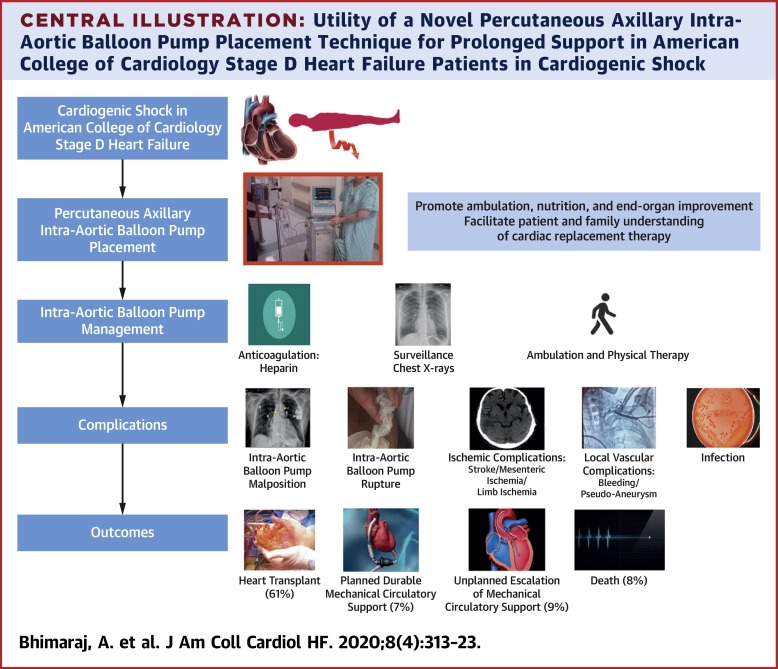JACC: Heart Failure ( IF 13.0 ) Pub Date : 2020-03-30 , DOI: 10.1016/j.jchf.2020.01.011 Arvind Bhimaraj 1 , Tanushree Agrawal 2 , Antonio Duran 2 , Omar Tamimi 2 , Javier Amione-Guerra 3 , Barry Trachtenberg 1 , Ashrith Guha 1 , Imad Hussain 1 , Ju Kim 1 , Mahwash Kassi 1 , Jiaqiong Xu 1 , Erik Suarez 1 , Uy Q Ngo 1 , Guillermo Torre-Amione 1 , Jerry D Estep 4

|
Objectives
This study presents the largest clinical experience of percutaneously placed axillary intra-aortic balloon pump (IABP) in patients with advanced heart failure.
Background
Transfemoral placement of IABP limits mobility and recuperation in patients who need prolonged support. We had previously reported a novel percutaneous method of IABP placement in the axillary artery and now present our expanded experience with this technique.
Methods
We performed a retrospective chart review of patients with advanced heart failure with percutaneous axillary IABP placement from November 2007 to June 2018 at Houston Methodist Hospital. We defined successful cardiac replacement therapy as heart transplant or left ventricular assist device implantation. We compared patients who had successful cardiac replacement with those who died and those who needed unplanned escalation of mechanical circulatory support.
Results
Of the 195 patients identified, 133 (68%) underwent successful cardiac replacement (120 transplants and 13 left ventricular assist device) as planned. End-organ function improved on IABP support in patients bridged to next therapy. There were 16 patients that died while on IABP support and 18 needed escalation of support. Higher right atrial/wedge ratio, higher right atrial pressure, smaller left ventricular end diastolic dimension, and ischemic cardiomyopathy were associated with death on the IABP in multivariate analysis. Post-transplant and post left ventricular assist device survival for those bridged successfully was 87% and 62%, respectively. Although bedside repositioning was frequent, 37% needed replacement for malfunction. Vascular complications occurred in a minority.
Conclusions
Percutaneous axillary approach for IABP placement is a feasible strategy for prolonged mechanical circulatory support in patients with advanced heart failure.
中文翻译:

晚期心力衰竭患者主动脉内气囊泵的经皮左腋动脉放置。
目标
这项研究为晚期心力衰竭患者提供了经皮放置腋窝主动脉内球囊泵(IABP)的最大临床经验。
背景
经股动脉放置IABP限制了需要长期支持的患者的活动能力和恢复能力。我们以前曾报道过一种在腋动脉中放置IABP的新型经皮方法,现在介绍了我们在该技术上的扩展经验。
方法
我们从2007年11月至2018年6月在休斯敦卫理公会医院对经皮腋窝IABP放置的晚期心力衰竭患者进行了回顾性图表回顾。我们将成功的心脏替代疗法定义为心脏移植或左心室辅助装置植入。我们比较了成功进行心脏置换的患者与死亡患者以及需要计划外的机械循环支持升级的患者。
结果
在确定的195例患者中,有133例(68%)按计划成功进行了心脏置换(120例移植和13例左心室辅助装置)。过渡到下一个治疗的患者在IABP支持下的终末器官功能得到改善。有16例在IABP支持下死亡,18例需要升级支持。在多因素分析中,IABP的死亡与右心房/楔形比高,右心房压力高,左心室舒张末期小,缺血性心肌病有关。对于成功桥接的患者,移植后和左心室辅助装置的存活率分别为87%和62%。尽管经常在床边重新放置,但仍有37%的患者需要更换才能恢复正常。少数发生血管并发症。
结论
IABP植入的经皮腋窝入路是晚期心力衰竭患者延长机械循环支持的可行策略。



























 京公网安备 11010802027423号
京公网安备 11010802027423号